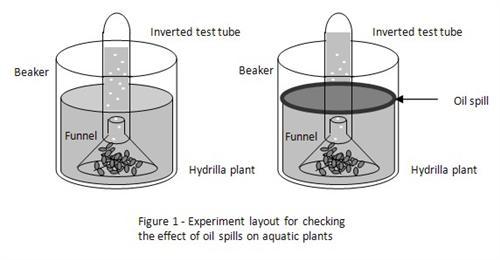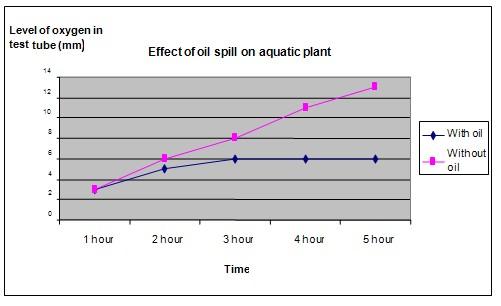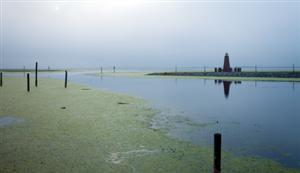| Complexity level: | 5 |
| Project cost ($): | 20 |
| Time required: | 1 hour for preparation, 1 day for observation |
| Material availability: | Easily found |
| Safety concerns: | None |
Hypothesis
The plant living in the beaker with a layer of oil on the surface will not be able to perform photosynthesis, and will hence stop producing oxygen.
Overview
Effects of oil spills
Oil is an organic fluid that has a lower density than water. When oil is spilled on water, it will float on the water surface and form a thin layer. Oil is not soluble in water. This thin layer of oil on the water surface is called sheen and it can kill the aquatic animals and plants that live beneath the water if it is not removed quickly.
The presence of oil on the water surface will blocks sunlight and prevents air from reaching the plants that live in the water. This will prevent the plants from producing food through photosynthesis. Without photosynthesis, the plants will not be able to grow, germinate and produce oxygen. If this condition persists, the plants will eventually die.
Aquatic animals are also not spared by oil spills. They are affected through physical contact, inhalation, ingestion and absorption of oil. The oil also contaminates the algae, plankton, fish eggs and larvae that are food for the smaller fishes. These smaller fishes are eventually eaten by the bigger fishes, birds, other animals and humans. The food chain becomes contaminated and everyone becomes affected.
Scientific Terms
Materials
The materials required for this science fair project:
- 2 hydrilla plants (of approximately equal size)
- 2 beakers
- 2 test tubes
- 2 funnels
- 1 liter of water
- 1 ruler (measuring 150mm long)
- 10ml of engine oil
Procedure
1. For this science fair project, the independent variable is whether or not there is a layer of oil on the surface of the water. The dependent variable is the amount of oxygen collected in the test tube. This is determined by measuring the length of the air trapped in the test tube with the ruler. The constants (control variables) are the size of the hydrilla plant, the size of the beaker, the amount of water and the size of the test tube used for air collection.
2. Fill each of the 2 beakers with 300ml of water and place one hydrilla plant inside each beaker. Next, invert the funnels and place them over the hydrilla plants in the beakers. The plant should be positioned inside the inverted funnel as shown in Figure 1 below.
3. Fill 2 test tubes with water and place them over the outlet of the funnels, as shown in Figure 1. There should not be any air inside the inverted test tubes before the start of the experiment.
4. Pour 10ml of engine oil into one of the beakers. The oil will spread evenly to form a thin layer.
5. Observe the amount of air collected in the test tubes to determine the level of oxygen produced by the hydrilla plants. Using a ruler, measure the height of the oxygen in the test tubes. Record your observations every hour for the next 5 hours.



Results
The hydrilla plant in the beaker with a layer of oil stopped producing oxygen after 3 hours, while the plant in the beaker without the oil continued to produce oxygen even after 5 hours.
| Condition | Amount of oxygen produced by the hydrilla plant (mm) | ||||
| 1 hour | 2 hour | 3 hour | 4 hour | 5 hour | |
| With oil | 3 | 5 | 6 | 6 | 6 |
| Without oil | 3 | 6 | 8 | 11 | 13 |
The above results were than plotted onto a graph, as shown below.

Conclusion
The hypothesis that the plant in the beaker with a layer of oil on the surface will not be able to perform photosynthesis and stop producing oxygen has been proven to be true.
Millions of gallons of oil are being discharged into our oceans every year and this is causing serious environmental problems. The source of these oil spills are careless handling, offshore oil drilling, oil tanker leaks, natural disasters and war. Oil spills contaminate water, kill aquatic plants and animals, cause coastlines to become tarred and destroy the ecosystem.
Also consider
The science fair project can also be repeated by limiting the light that enters the sides of the beaker by covering the sides with a cardboard.
The experiment may be modified to test for the growth of the plants, by measuring the weight of the plants before adding the oil and 3 days after adding the oil.
References
How does oil affect the growth of an aquatic plant? - http://www.ehow.com/about_6127348_oil-affect-growth-aquatic-plant_.html
The detrimental effects of oil spills on our environment - http://www.articlesbase.com/environment-articles/the-detrimental-effects-of-oil-spills-on-our-environment-1043176.html
The effects of oil spills on aquatic life and the environment - http://pollution-control.suite101.com/article.cfm/the-effects-of-oil-spills-on-aquatic-life-and-environments

